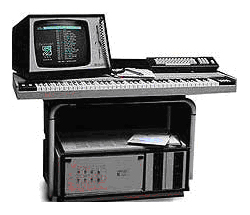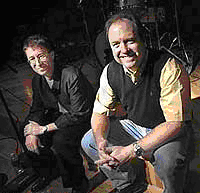
The Droid Be With You
In 1985 we saw a remarkable liaison between Lucasfilm and Convergence Corporation, with the formation of The Droid Works.
The SoundDroid workstation offered video synchronization, multitrack recording, sound synthesis, sample-accurate editing, mixing, dynamics and special effects, using a remarkable interface that incorporated touch-sensitive graphics, programmable functions, and servo faders.
In the same year, Digidesign introduced Sound Designer, which allowed a Mac to edit samples from an E-mu Emulator II. Eventually the firm would bundle SD software with custom Mac-compatible hardware to form Sound Tools.
And the Pro Tools juggernaut-to-be took its first baby steps.
One of earliest custom-developed DAWs was the AMS AudioFile. Its disk-based recording/editing functions are controlled from a user surface with video display, soft keys and QWERTY keyboard.
For several years, Lexicon offered Opus, a disk-based eight-track recorder/editor with hardware mixer plus signal processing.
Later, in contrast, the firm offered Lexicon Studio, a mixed hardware/software system that offered I/O, DSP, routing, time code sync and control for PC- or Mac-based audio production software.
Sonic Solutions opened for business in 1987 with its NoNoise for removing hiss, noise, clicks and pops; later the firm developed a series of powerful stereo and multichannel DAWs.
Meanwhile, WaveFrame unveiled AudioFrame, which offered powerful editing, recording, music synthesis, signal processing and mixing from an IBM PS/2 platform.
High End, Low End
Integrated Media Systems unveiled Digital Dyaxis in 1988, a Macintosh-based two-track recorder/editor that over the years expanded into a highly-popular multitrack DAW with disk-based video playback.
In the high-end, Solid State Logic unveiled ScreenSound, a custom-developed multitrack recorder/editor/mixer for post with-uniquely—all system functions controlled via a pen/tablet interface.

Four years later, SSL offered Scenaria, a 24-track/38-channel recorder/mixer with integrated random-access video playback.
Opcode Studio Vision arrived in 1990, combining MIDI sequencing with Digidesign’s Sound Tools editor.
A year later, Digidesign launched Pro Tools, which set high standards for reliability, flexibility, expandability and factory support, and is now in daily use in thousands of studios around the world. This Mac-based system incorporated multitrack recording and editing, full DSP, MIDI sequencing and digital mixing.
In 1992 we saw a remarkable democratization of DAWs, with the introduction of the Digital Audio Labs Card-D.
This humble plug-in card transformed an IBM 286/386-based PC into a full-function digital audio workstation. Innovative Quality Software’s SAW offered an alternative to DAL’s bundled software.
